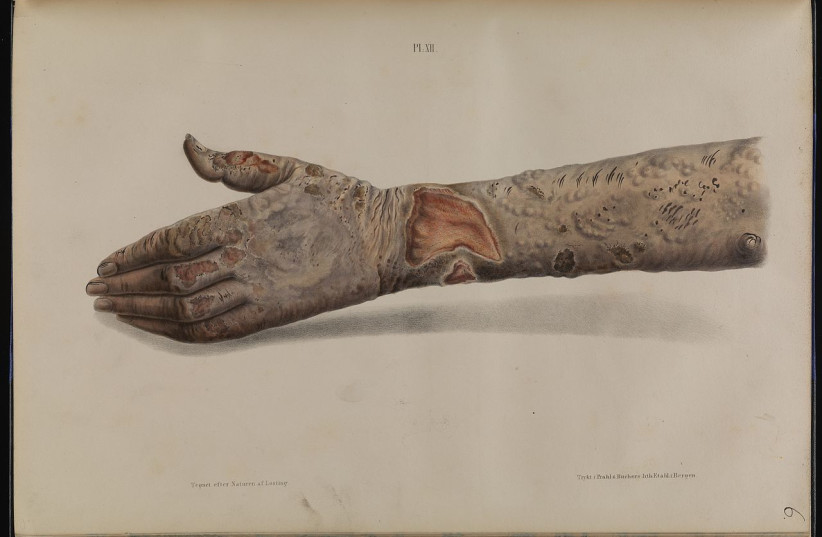Humans have always faced epidemics, many years before COVID-19. However, back then they did not have neither vaccines, which have accompanied humankind for only a little over two hundred years, nor antibiotics, which have been around for just over eighty years, and they certainly did not have antiviral medications. However, whenever there were contagious diseases, there were rules for maintaining public health, and some were very similar to those we are familiar with, from the current pandemic. Yes, even in Biblical times people realized that preventing the spread of a disease was preferable to treating it, regardless of the efficacy of the available treatments.
From Biblical Leprosy to Smallpox
Definition: Today, when people use the term leprosy, they refer to Hansen’s disease, a long-term bacterial skin infection that can be cured with standard antibiotic treatment. Biblical leprosy was something entirely different, and in fact, it was many different things. In practice, the term “Leprosy” referred to a variety of skin conditions and rash-causing diseases. Although these were labeled as a single ailment, chapter 13 in the Book of Leviticus not only included precise instructions for their treatment and prevention, but also made an interesting distinction between contagious and non-contagious diseases. This classification called for a clear distinction between diseases that required isolation of the patients and their separation from the public, to keep the majority of the population healthy, and diseases in which there was no reason for the patient not to remain alongside healthy people, since there was no fear of contagion. For example, a disease that causes a full-body rash is described in Leviticus 13:12 - “And if a leprosy break out abroad in the skin, and the leprosy cover all the skin of him that hath the plague from his head even to his foot, wheresoever the priest looketh”.
Research provided by the Davidson Institute of Science Education
This is clearly not a description of Hansen’s disease. What was it then? It is difficult to say with certainty. One diseases that cause lesions all over the body is smallpox, which was one of the deadliest diseases in human history, eradicated in 1980 thanks to a global vaccination campaign. The causative agent of smallpox was a virus transmitted by coughing or through speech. Following contagion, patients suffered from high fever and a whole-body rash. The rash presented itself in the form of fluid-filled blisters that contained large amounts of the virus and were highly contagious. But the main problem was not the rash, but the fact that the virus targeted all organs, leading to a nearly 30 percent mortality rate.


How it was dealt with: before the existence of a vaccine against smallpox (which was developed in the 18th century by physician Edward Jenner), contagion had to be prevented using other methods. The Book of Leviticus, describes how people with this type of “leprosy” were forced to stay in their dwellings until all the rash disappeared and the skin regained its original color. Only then could the person resume normal life and come into contact with healthy people, assuming, naturally, that he has survived the disease. Obtaining a permit to terminate this medical isolation required authorization by a skilled priest, the only person who could rule that the afflicted person has indeed recovered.
This was an interesting way for patient isolation, which may have endangered the health of the priest who was expected to make decisions concerning the nature of the person's disease and its potential danger to society. However, since no one beside the priest was allowed to come in contact with the patient, the patient remained isolated, rather than in the company of other “lepers”, potentially suffering from other diseases, who could become infected with the deadly disease and spread it.
"Stopping the “Black Death”
Definition: The Bubonic plague of the 14th century was probably the most famous plague in history, and rightfully so. Beyond the primary devastation it caused, it also played a main role in bringing about large-scale changes in Europe’s social and economic structures. It is also remembered as an especially deadly plague, both for being extremely deadly indeed, as well as for hitting most severely the densely populated city centers, with images of bodies piling up in the streets having become a collective cultural nightmare to this day.
The question of where exactly the Bubonic plague started remains unanswered to this day. There are claims that the original outbreak was in Siberia, while some claim that it began in China. What’s clear is that the outbreak in Europe began in the city of Kaffa in the Crimea, where it most likely arrived on board a merchant ship, soon spreading across Italy and the rest of Europe.
The causative agent of the Bubonic plague is a bacteri, transmitted via the bite of an infected flea, from an infected animal, such as a rat or a squirrel, to another animal, including humans. An infected person would suffer from high fever, swollen lymph nodes and a generally bad feeling. This is the best-case scenario. In the next to-best-case scenario, the bacteria would reach the lungs and cause severe pneumonia. In the worst-case scenario, the bacterial infection would cause sepsis and death. Up until the invention of antibiotics, the fatality rate of the Bubonic plague was between 30-100 percent, depending on the type of disease the person developed.
How it was dealt with: today, antibiotics are used to treat the bacterial infection, and the disease usually passes quickly and easily. In the past, however, aside from reducing the fever, relieving the pain and trying to prevent further contagion, there was no practical way of caring for the sick.
In 1377 the city of Dubrovnik, found in modern-day Croatia, was the first to lockdown and forbid merchants and anyone who did not live inside the city to enter it, in order to stop the spread of the disease. The quarantine period was initially set to thirty days and was later extended to forty. In fact, the word ‘quarantine’ originates from the Italian word quarantena, meaning ‘forty days’. This new method spread to other places in Europe. It included isolation of the sick and also of those who had arrived from regions where the disease was rampant, to make sure that they were not sick. Although 14th century people knew nothing about bacteria or viruses and lacked the medical knowledge we have today, they were certainly not stupid. They understood very well that a sick person can infect healthy individuals, and correctly deduced that by preventing a sick or a potentially sick person from being in contact with healthy individuals, the risk of the disease spreading through the city could be lowered considerably.
The idea of quarantine was conceived in the 14th century, and although far from being a perfect method for stopping infectious diseases, it is very effective in reducing both morbidity and mortality rates. This method is still considered to be an effective tool for dealing with a fast-spreading new disease and it is being used in many places in the world to deal with the COVID-19 pandemic.
The Flu That Came After The War
Definition: While the Bubonic plague in the 14th century was a devastating event for Europe in the Middle Ages, the 1918 Spanish flu caused a havoc of a very different manner in early 20th century United States. Two things were especially devastating about it - its timing and the identity of its victims. It hit right at the end of the World War I and its highest mortality rate was among young adults, who were supposed to be healthy and strong.
Flu (influenza) is a viral disease, but science was not yet aware of the existence of viruses in the second decade of the 20th century. It is transmitted by coughing, sneezing and speaking, and causes high fever, pain, and, naturally, a runny nose and cough. The problem with the 1918 influenza was naturally not the runny nose, but the high rate of complications caused by the disease and its high mortality rate. It is estimated that mortality rates were between five to twenty percent.
Similar to many other diseases, death from the flu can be due to the virus itself or due to complications caused by the disease, most notably pneumonia. Autopsies performed on victims of the Spanish flu often found that the disease caused direct damage to the lungs, and in contrast to most strains of the flu, the patients did not die of complications such as bacterial pneumonia.
Similar to what can be observed today with respect to the COVID-19 pandemic, the 1981 influenza pandemic occurred in a number of waves of outbreak. All the waves were lethal, causing the medical system to collapse due to heavy patient load, especially after being already at the end of its tether, due to wartime economy and the care for the injured soldiers coming from the battlefields in Europe.
How it was dealt with: one of the first large cities to act systematically against the epidemic was St Louis, Missouri. First, the authorities demanded an accurate record of all flu cases in the jurisdiction, in order to create a database, based on which informed decisions could be made. As a next step, all theaters, schools and public institutions were closed and any non-essential gatherings were banned, to prevent the disease from spreading.
In view of current concern about a possible pandemic of virulent avian influenza, it is timely to revisit the public health response to the "Spanish" influenza of 1918. St. Louis, Missouri, was the most successful of nine largest cities in limiting the death toll from influenza and pneumonia, owing to the rigorous use of public health measures during the first 8 weeks of the epidemic. A second wave of cases increased the final death rate, but it still remained below that of other major cities. Public health officials attributed the lower death rate to the early and rigorous ban on public gatherings.
The last stage was isolating the sick in order to reduce their contact with healthy people who may get infected, just as they did in Biblical times. Anyone suspected to have contracted the disease was required to stay at home until receiving a medical confirmation that they had fully recovered. After these precautions proved successful in reducing the number of sick people, it was decided to lift the ban on public gatherings. As expected, the result was a new wave of disease outbreak, followed by reinstatement of all the previous measures.
The Key: Preventing Infection
Human beings are social creatures, and throughout history, bacteria and viruses were able to exploit this fact to spread from person to person and cause epidemics. It is therefore not surprising that throughout the several thousands of years of documented human civilization, long before the disease causing agents were discovered, people understood that the basis for preventing the spread of an infectious disease is to break the cycle of infection by preventing sick people from coming into contact with healthy people. This principle still aids us today in dealing with any plague, be it a local outbreak of head lice or a global pandemic.
This research was first published at the Davidson Institute of Science Education.
